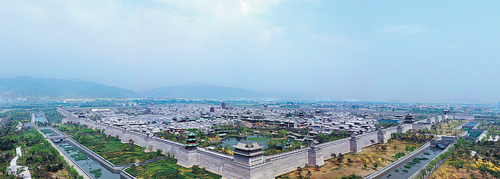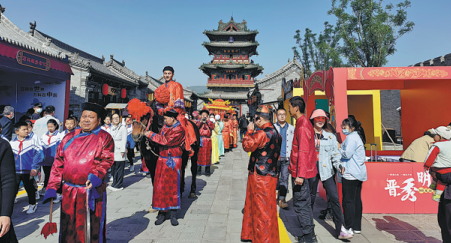
A 3,700-meter-long city wall is rebuilt for the Old Taiyuan county seat. [Photo by Han Shuangxi for China Daily]
If not for a devastating fire in the early Song Dynasty (960-1279), the city center of Taiyuan, capital of Shanxi province, would be 10 kilometers southwest to its present location.
In ancient times, Taiyuan was called Jinyang, and was a city built more than 2,500 years ago. After nearly 1,500 years of prosperity, the old city was razed to the ground by Zhao Guangyi, the second emperor of the Song Dynasty.
Several years later, a newer city was built to its northeast, which is today's city of Taiyuan.
During the early Ming Dynasty (1368-1644), local officials built a smaller city on the location of fire-destroyed site, to act as the seat of Taiyuan county, an administrative region under the jurisdiction of Taiyuan city.
Construction of the county seat, which is called "Old Taiyuan" locally, was completed in 1375.
Resembling a phoenix, the old city is also sometimes referred to by locals as "Phoenix City".
Like many ancient cities in China, Old Taiyuan is no longer intact after weathering wars, winds and rains over the last six centuries. Most of its city walls are gone and many ancient structures destroyed.
But in 2013, tourists and residents alike became excited at the news of the launch of a renovation project, aimed at restoring Old Taiyuan to its former glory.
After eight years, "new" Old Taiyuan was opened to visitors on May 1. The city walls have been rebuilt based on their original look and ancient structures inside the city have been repaired.

A show featuring a traditional wedding is held in Old Taiyuan in early May. [Photo by Sun Ruisheng/China Daily]
Zhou Ailan, a resident from an area neighboring Old Taiyuan, was among the first visitors on the opening day.
Zhou, in her 60s, said she had been a witness to the changes of Old Taiyuan over the past decades.
"Since my childhood, I have frequently visited relatives in Old Taiyuan," Zhou said. "I was excited with a number of ancient buildings here but regretted the decay and collapse of some old structures over the decades.
"Many of the old structures have been restored to what I saw decades ago."
According to officials at the Old Taiyuan scenic area, the renovated city is now home to 79 historical sites, with more than 300 old buildings kept intact.
According to Li Yongqiang, Party secretary of Jinyuan district-which administrates the scenic area-Old Taiyuan is expected to become a major tourist destination in Taiyuan alongside attractions such as Jinci Temple, Jinyang Lake and Taishan, and Tianlong mountains.
"Like Jinci, the oldest temple complex in Taiyuan, the Old Taiyuan scenic area will be a major site for tourists to explore the millennia-long history of Taiyuan and Shanxi province," Li said.
Wu Jia contributed to this story.
